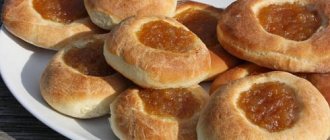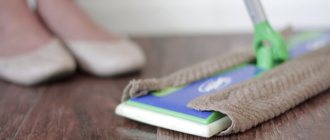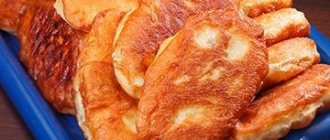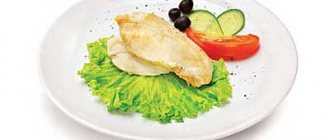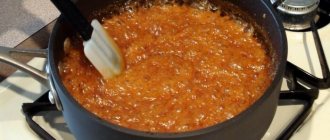Most of us have a sweet tooth to one degree or another. Therefore, all sorts of goodies come to our table at different intervals: chocolate, caramel, ice cream, cookies and, of course, a variety of baked goods. Buns are especially popular among the latter. They differ in shape, size, smell, color, filling. But all buns are loved by both children and adults.
Many people with a sweet tooth know from their own experience how sweets affect their figure. It is not surprising that sooner or later they ask themselves the question: how often and in what quantities can they eat buns in order to pamper themselves and not gain extra pounds? Let's try to figure it out.
About the buns:
What are the calorie content of buns, what dietary properties do they have? All this is very interesting for those who are trying to lead a healthy lifestyle and take care of their health and figure. So we will try to answer these questions in the next article.
So here it is:
Buns are baked from yeast dough. The main components of yeast dough are flour, liquid (milk, water, a mixture of milk and water or cream), yeast, salt. Depending on the type of dough, fats (butter, margarine, vegetable oil or animal fats), eggs or egg yolks, sugar, flavorings, raisins, candied fruits, etc. are added.
You can also add boiled potatoes, pumpkin, carrots or cottage cheese to the yeast dough.
Yeast mushrooms reproduce best at a temperature of 28-35 ° C, so the liquid intended for the dough is heated to 30-35 ° C, and other products are first kept in a warm room. Knead the dough, let it rise (under a napkin) and shape it in a warm room with an even temperature, without drafts.
The cutting board should also be kept in a warm room before use so that the dough does not cool down during shaping.
In the cold, yeast multiplies slowly; if the temperature is too high, they die and the dough does not rise.
Basic yeast dough recipes:
Recipe 1:
½ liter of milk or a mixture of milk and water, 25-30 g of yeast, 1 tbsp. l. sugar, 1 teaspoon of salt, 50 g of margarine or fat, 900 g of wallpaper flour or premium or 1st grade wheat flour.
Recipe 2:
½ liter of milk or a mixture of milk and water, 25-30 g of yeast, 25-100 g of sugar, 1 teaspoon of salt, 1 teaspoon of crushed cardamom, 1 egg, 50-100 g of butter or margarine, 800-900 g of flour.
Recipe 3:
½ l milk or 20% sour cream, 50-60 g yeast, 100-200 g sugar, ½ -1 teaspoon salt, ½ - 1 teaspoon chopped cardamom, grated zest of ½ lemon, 2 eggs or 3-4 egg yolks , 150-250 g butter or margarine, 1-1.1 kg flour, premium, if desired, 2 tbsp. spoons of chopped candied fruit, 100-200 g of raisins.
Almost always, buns have increased nutritional value and calorie content. This is not always a plus: anyone who fears for their figure or leads a sedentary lifestyle considers such nutritional value of buns as the main enemy of their figure. However, it is the calorie content of the bun that allows it to satisfy hunger during hard work or in conditions of an inconsistent diet.
“Lace” baked goods – aromatic, tasty, airy!
With this simple recipe you will bake a truly confectionery masterpiece! Your buns will be appreciated by everyone without exception, even the most capricious gourmets. Shall we try?
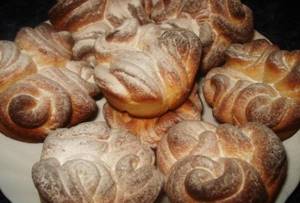
Ingredients:
- flour (pre-sifted) – 350 g;
- yeast (dry) – 10 g;
- eggs (yolks) – two pieces;
- sugar - three and a half tablespoons;
- vanilla – one bag;
- softened butter – 75 g;
- milk – 145 ml;
- salt – 0.5 teaspoon;
- powdered sugar.
Preparation:
- Let's prepare the listed components.
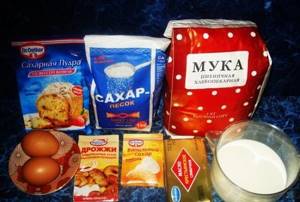
- Let's warm up the milk a little. Add a teaspoon of sugar to it and stir.

- Pour yeast into the resulting mixture.
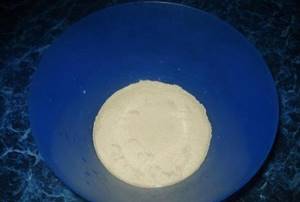
- Stir well.
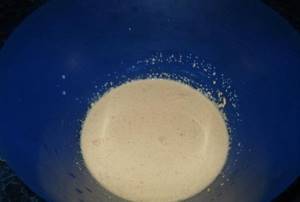
- Cover the container with the milk-yeast mixture with a towel and leave it warm for ten minutes.
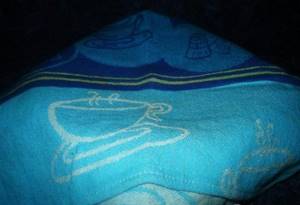
- Sift the flour into another container.
- Add sugar, vanilla, and salt to it. Let's stir.
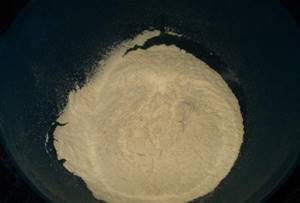
- Separate the yolks from the protein mass.
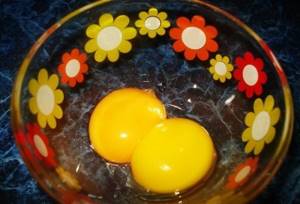
- Cut the soft butter into small pieces.
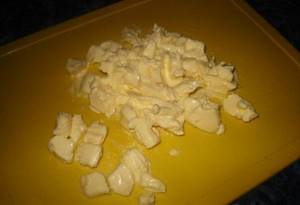
- Add the milk-yeast mass to the flour mixture.
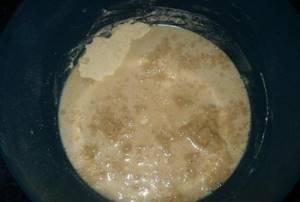
- Add the yolks.

- Stir well.

- Add pieces of butter and stir again.
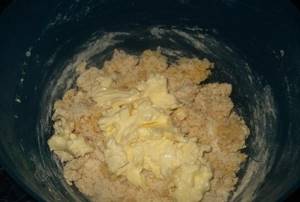
- Knead the base for at least ten minutes. We need it to stop sticking to our hands.

- Cover the container with the preparation with a towel. Leave for one and a half hours. During this time it will rise.

- After the specified time has passed, knead the base. Roll it out carefully into a layer of medium thickness.
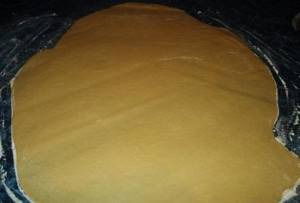
- We cut circles with a diameter of five to six millimeters on the workpiece. You can use a glass or mold for this.

- Now we form the buns. We take three blanks and fold them in this way.
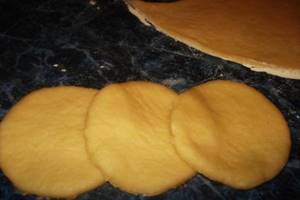
- Roll them into a tube.

- Cut the workpiece into two equal parts.

- We will have such interesting roses.
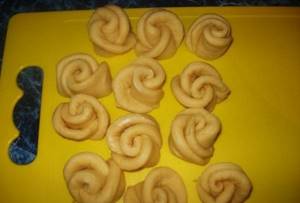
- We put the blanks in the mold.

- Brush the buns with sweetened milk. Let's leave them for about fifteen minutes so that the pieces rise slightly.
- We bake the treat for fifteen to twenty minutes at one hundred and eighty degrees.
- Sprinkle the buns with powder. Ready!
How many calories are in buns?
Here's how much:
Naturally, the calorie content of buns depends on the type and method of preparation.
Pay attention to this table:
Table of calorie content of buns and nutritional value (BJU) per 100 grams:
| Buns: | Bel, gr. | Fat, gr. | Angle, gr. | Cal, kcal. |
| Puff | 5.8 | 27.2 | 52.0 | 476 |
| With raisins | 7.8 | 6.6 | 67.5 | 361 |
| With apple | 6.5 | 17.0 | 67.0 | 450 |
| With jam | 4.4 | 8.7 | 51.0 | 295 |
| With cottage cheese | 11.3 | 11.4 | 42.0 | 320 |
| With sugar | 6.4 | 12.6 | 41.0 | 258 |
| With poppy seeds | 7.6 | 11.3 | 53.0 | 347 |
| With cinnamon synabon | 4.5 | 14.3 | 56.0 | 361 |
| For tea | 7.2 | 6.2 | 51.0 | 317 |
| Calorie | 7.3 | 9.6 | 62.4 | 363 |
| Otrubnaya | 7.8 | 1.8 | 43.9 | 220 |
| Stolichnaya | 8.4 | 2.2 | 52.8 | 270 |
| 8 cereals | 13.9 | 5.3 | 43.7 | 277 |
| With sesame | 9.6 | 4.2 | 59.5 | 320 |
The buns are different - rich, yeasty and sweet!
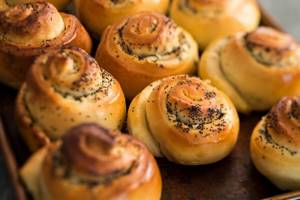
We often add poppy seeds to both pies and buns. How many calories are in a bun with poppy seeds? A one hundred gram serving of such baked goods will contain approximately three hundred and ten kilocalories. As for fats, there will be 8.4 g of them in such a bun, 12.5 g of proteins, and 61.3 g of carbohydrates.
On a note! Any bun “gives” us not only extra pounds, but also useful components. However, the downside of baking is empty carbohydrates, which lead to weight gain.
The calorie content of baked goods depends on the base on which it is prepared and on the filling. How many calories are in a bun with jam? Such baked goods bring us two hundred and ninety-five kilocalories. And if the pastry is with raisins, it will have two hundred and ninety kilocalories. The calorie content of filled buns is lower than that of plain buns because they require less dough.
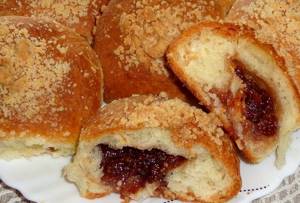
Many buns are sprinkled with granulated sugar or cinnamon powder. How many calories are in a bun with sugar? The calorie content of such baked goods is three hundred thirty-nine kilocalories per one hundred gram serving. How many calories are in a cinnamon roll? It will contain three hundred and forty-seven kilocalories.
On a note! Cinnamon is rich in vitamin components of various groups, as well as minerals. Since it is slightly bitter, granulated sugar is added to baked goods along with it.
Now let's look at the energy value of the most common types of buns. So, bran buns are a real salvation for the diet menu. One hundred grams of such a treat contains two hundred and twenty kilocalories. How many calories are in a bun? This delicacy includes buns with granulated sugar, as well as pastries with a puff base. The butter dough contains a considerable amount of eggs, milk, and butter. Accordingly, baked goods based on it will be quite high in calories - three hundred thirty-nine kilocalories.
For sandwiches and sandwiches, many people choose “Capital” buns. A one hundred gram serving of such baked goods contains two hundred and seventy kilocalories. However, if the bun is supplemented with jam, honey or cheese, its calorie content will be higher.
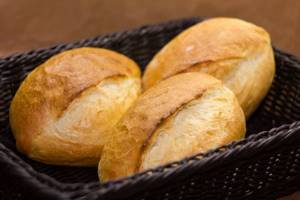
On a note! By eating one Stolichnaya bun for lunch, you will get your daily requirement of iron.
Many adherents of a healthy menu cannot do without 8-grain buns. These baked goods are prepared using eight types of flour and grains. Its calorie content is two hundred seventy-seven kilocalories per hundred grams.
Gourmets love Burgundy buns. The custard base, complemented with cheese, gives the baked goods creamy notes and airiness. Its one hundred gram serving will contain two hundred and twenty-six kilocalories.
No less popular are the “Sandwich” buns with sesame seeds. Their energy value is three hundred twenty kilocalories. But hamburger buns contain two hundred and seventy-two kilocalories. The most high-calorie buns from this “series” will be buns intended for hot dogs. They contain three hundred thirty-three kilocalories.
As already mentioned, the calorie content of any baked product is associated with the components added to it. If you supplement the buns with jam, be prepared for the fact that their calorie content will be two hundred and ninety-six kilocalories. Baking with cottage cheese will bring you three hundred twenty-three kilocalories.
Glazed buns contain two hundred and fifty-six kilocalories, and with chocolate – three hundred and thirty-one. A muffin with condensed milk brings us three hundred and fifteen kilocalories, with apple filling – two hundred and twenty. And baked goods with fudge contain two hundred and sixty-three kilocalories.
On a note! Different manufacturers may have different calorie content for the same products.
And a little about secrets.
The story of one of our readers Alina R.:
I was especially depressed about my weight. I gained a lot, after pregnancy I weighed as much as 3 sumo wrestlers together, namely 92 kg with a height of 165. I thought the belly would go away after giving birth, but no, on the contrary, I began to gain weight. How to cope with hormonal changes and obesity? But nothing disfigures or makes a person look younger than his figure. At the age of 20, I first learned that plump girls are called “WOMAN” and that “they don’t make clothes that size.” Then at the age of 29, divorce from my husband and depression.
But what can you do to lose weight? Laser liposuction surgery? I found out - no less than 5 thousand dollars. Hardware procedures - LPG massage, cavitation, RF lifting, myostimulation? A little more affordable - the course costs from 80 thousand rubles with a nutritionist consultant. You can, of course, try to run on a treadmill until you go crazy.
And when will you find time for all this? And it's still very expensive. Especially now. Therefore, I chose a different method for myself.
Nutritional value and chemical composition of "Bun with glaze."
| Nutrient | Quantity | Norm** | % of the norm in 100 g | % of the norm in 100 kcal | 100% normal |
| Calorie content | 370 kcal | 1684 kcal | 22% | 5.9% | 455 g |
| Squirrels | 8 g | 76 g | 10.5% | 2.8% | 950 g |
| Fats | 12 g | 56 g | 21.4% | 5.8% | 467 g |
| Carbohydrates | 60 g | 219 g | 27.4% | 7.4% | 365 g |
The energy value of a bun with glaze is 370 kcal.
Primary Source: Created in the application by the user. Read more.
** This table shows the average levels of vitamins and minerals for an adult. If you want to know the norms taking into account your gender, age and other factors, then use the “My Healthy Diet” application.

Soft yeast buns with poppy seeds for breakfast or afternoon tea, for family evening tea or for Sunday friendly gatherings over a cup of aromatic coffee. These buns don’t need an occasion, they are good at any time of the day, any day of the week.
Properties of Buns
Nutritional information | Vitamins | Minerals
How much does the Bun cost (average price for 1 piece)?
Moscow and Moscow region.
20 rub.
Perhaps buns can be considered the most famous type of baked goods. Buns are a type of baked goods made from yeast dough, which is distinguished by its round shape. In the modern culinary tradition you can find hundreds of different recipes for buns. Professionals and true masters of culinary art call buns a universal food product that can be used in a variety of ways. For example, buns are served as an independent dessert or as an addition to soups.
Harm of buns
However, low-calorie and healthier buns are not so wildly popular among the majority of residents of our latitudes. As a rule, we buy buns made from wheat flour in stores or bakeries. Such bakery products are contraindicated for obese people. First of all, the harm of buns affects your digestion, and then your figure. Uncontrolled consumption of any baked goods, including buns, will not just harm your figure, but cause significant damage to your health. There will be no harm from buns if you consume the culinary product in moderation.
How is calorie content formed?
The calorie content of a dish is calculated very simply. It is known that all products contain proteins, fats and carbohydrates. One gram of proteins and carbohydrates contains 4 kilocalories each, and a gram of fat contains 9. By multiplying the values for a particular dish by the calorie coefficient, and then summing the three resulting numbers, you can get the result.
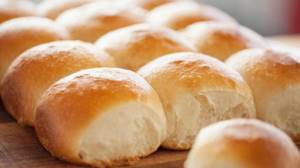
It is important to note that calorie content is not the only indicator of the dietary content of a product. Two or three apples, the total calorie content of which will be 150-200 kilocalories, are not identical to the same amount of calories obtained from a dessert with cream.
